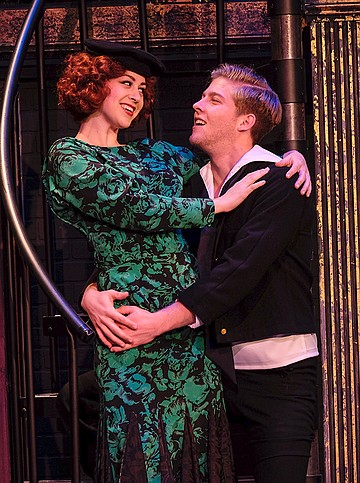 Facebook
Facebook
 X
X
 Instagram
Instagram
 TikTok
TikTok
 Youtube
Youtube

“What would you do, my brave young friend?”
Elderly Fraulein Schneider sings these haunting lyrics in Kander and Ebb’s iconic musical, and these words are at the heart of Ray Limon’s current production at the Welk.
Cabaret takes place in Berlin during the Weimar Republic, a time of economic and political flux in Germany. The primary story centers on Clifford Bradshaw, an American novelist come to Berlin for artistic inspiration, and Sally Bowles, a British cabaret performer at the Kit Kat Klub. Around them swirl personalities and performers who depict the various perspectives of those struggling to survive in difficult times.
The show starts with Doug Davis’s impressive set design. Large gold frames cover a two-story unit that provides literal framing devices in which the performers create tableaux akin to pictures of Weimer cabarets.
Jeffrey Scott Parsons is an attractive Emcee of the Klub, although his character falls short of being sufficiently enticing or frightening. That said, however, he is entertaining during moments of frustration with an unresponsive audience, shooting periodic jabs at seeming apathy toward his efforts.

Ashlee Espinosa as Sally Bowles is unexciting, but she shines most in scenes with Cliff, masterfully played by Eric Hellmers. Their moments together feel honest and heartbreaking.
Charlene Koepf is dynamic as Fraulein Kost. Her mesmerizing moment as a Dietrich-like lounge singer for “Married,” which she sings entirely in German, is exceptionally beautiful.
The true stars of the production are Susan E.V. Boland as Fraulein Schneider and David Allen Jones as Herr Schultz. Their portrayals of elderly individuals caught in the middle of a society changing around them in terrifying ways feels powerfully poignant. If there is one reason to see this production, it is to see Boland and Jones bring these tragic characters to life.
Music director Justin Gray did a fine job; the music provided by the orchestra is beautiful and the cast sounds good. Costumes by Janet Pitcher, however, leave much to be desired, as the Kit Kat Klub performers look more like models out of a Hot Topic advertisement than 1931 Berlin.
As a whole, the production seems afraid of the content added to the show in 1987 — most of which came from Bob Fosse’s hit film adaptation. Dance numbers “Mein Herr” and “Money” borrowed from the film, for example, are clumsy and awkward in execution. The best moments of the production are the ones retained from 1966, especially the scenes in Fraulein Schneider’s boarding house.
Despite its PG-13 rating, the production is safe and predictable, even when trying to be risqué. The musical numbers are adequately performed, but the show shines with its acting. The play at the heart of the musical has been given inspiring life and by the end leaves one questioning, “What would I do if it were me?”


“What would you do, my brave young friend?”
Elderly Fraulein Schneider sings these haunting lyrics in Kander and Ebb’s iconic musical, and these words are at the heart of Ray Limon’s current production at the Welk.
Cabaret takes place in Berlin during the Weimar Republic, a time of economic and political flux in Germany. The primary story centers on Clifford Bradshaw, an American novelist come to Berlin for artistic inspiration, and Sally Bowles, a British cabaret performer at the Kit Kat Klub. Around them swirl personalities and performers who depict the various perspectives of those struggling to survive in difficult times.
The show starts with Doug Davis’s impressive set design. Large gold frames cover a two-story unit that provides literal framing devices in which the performers create tableaux akin to pictures of Weimer cabarets.
Jeffrey Scott Parsons is an attractive Emcee of the Klub, although his character falls short of being sufficiently enticing or frightening. That said, however, he is entertaining during moments of frustration with an unresponsive audience, shooting periodic jabs at seeming apathy toward his efforts.

Ashlee Espinosa as Sally Bowles is unexciting, but she shines most in scenes with Cliff, masterfully played by Eric Hellmers. Their moments together feel honest and heartbreaking.
Charlene Koepf is dynamic as Fraulein Kost. Her mesmerizing moment as a Dietrich-like lounge singer for “Married,” which she sings entirely in German, is exceptionally beautiful.
The true stars of the production are Susan E.V. Boland as Fraulein Schneider and David Allen Jones as Herr Schultz. Their portrayals of elderly individuals caught in the middle of a society changing around them in terrifying ways feels powerfully poignant. If there is one reason to see this production, it is to see Boland and Jones bring these tragic characters to life.
Music director Justin Gray did a fine job; the music provided by the orchestra is beautiful and the cast sounds good. Costumes by Janet Pitcher, however, leave much to be desired, as the Kit Kat Klub performers look more like models out of a Hot Topic advertisement than 1931 Berlin.
As a whole, the production seems afraid of the content added to the show in 1987 — most of which came from Bob Fosse’s hit film adaptation. Dance numbers “Mein Herr” and “Money” borrowed from the film, for example, are clumsy and awkward in execution. The best moments of the production are the ones retained from 1966, especially the scenes in Fraulein Schneider’s boarding house.
Despite its PG-13 rating, the production is safe and predictable, even when trying to be risqué. The musical numbers are adequately performed, but the show shines with its acting. The play at the heart of the musical has been given inspiring life and by the end leaves one questioning, “What would I do if it were me?”
Comments